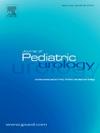Agreement between two uroflowmetry tests in children with lower urinary tract symptoms
IF 2
3区 医学
Q2 PEDIATRICS
引用次数: 0
Abstract
Uroflowmetry is a non-invasive examination considered as a first-line assessment for children with lower urinary tract symptoms (LUTS). Currently, the performance of two uroflowmetry tests is recommended by ICCS for all patients with LUTS. This study aims to evaluate the differences between two uroflowmetry tests in children with lower urinary tract symptoms and their impact on the patient's diagnostic workup and clinical outcome. Forty patients with LUTS, aged 4–17 years, were evaluated prospectively with two consecutive uroflowmetry tests and ultrasonography. They were classified based on the ICCS criteria for curve pattern and divided into two groups based on the SPU classification of fractionated (staccato and intermittent) and smooth (bell, tower and plateau). They were also separated into three groups based on estimated bladder capacity (voided volume + post-void residual on ultrasound): high (>115%), low (<60%) or normal capacity. The mean age was 8 (IQR 6.0–10.0) years and 25 (62.5%) patients were female. There was an increase in nonbell-shaped curves from the first (32.5%) to the second test (52.5%). The curve shape between the uroflowmetries based on ICCS classification showed a Kappa value of 0.349 (fair). Classifying curves as fractionated or smooth yielded a Kappa value of 0.714 (substantial) (table). The Bland–Altman test showed disagreement in the parameter of time to Qmax. There was a significant difference in categorizing bladder capacity as high, low, or normal: it was concordant in 63.6% for high, 68.4% for normal and 50% for low capacity (p = 0.001). Despite the disagreement found classifying the curves based on the ICCS pattern, also demonstrated in other studies, there was a substantial agreement using the SPU criteria. It reinforces the greater reliability of the SPU system and it may be the key to reduce the subjectivity of uroflowmetry. Even though this classification being associated with a higher agreement in interpretation of the curves, repeating uroflowmetry does not present a clinically significant divergence that changes the patient's diagnostic workup. Our study is limited by the lack of EMG and larger sample. Considering the flow curve pattern, the agreement between two uroflowmetries was substantial according to the SPU and only reasonable by the ICCS classification. Regardless of some differences found between the flows, a second uroflowmetry test might not have clinical relevance that justifies its recommendation for all patients.下尿路症状儿童的两种尿流率测试之间的一致性
尿流率测定是一种无创检查,被认为是下尿路症状(LUTS)儿童的一线评估方法。目前,ICCS 建议对所有下尿路症状患者进行两次尿流率测定。本研究旨在评估两种尿流率测定法在儿童下尿路症状患者中的差异及其对患者诊断工作和临床结果的影响。研究人员对 40 名 4-17 岁的下尿路症状患者进行了前瞻性评估,连续进行了两次尿流率测定和超声波检查。他们根据 ICCS 的曲线模式标准进行分类,并根据 SPU 的分类标准分为两组,即分段式("咯噔 "和 "间歇")和平滑式("钟 "形、"塔 "形和 "高原 "形)。他们还根据估计的膀胱容量(超声检查显示的排尿量+排尿后残余物)分为三组:高容量组(>115%)、低容量组(<60%)或正常容量组。平均年龄为 8(IQR 6.0-10.0)岁,25 名(62.5%)患者为女性。从第一次测试(32.5%)到第二次测试(52.5%),非铃型曲线有所增加。基于 ICCS 分类的尿流测量曲线形状的 Kappa 值为 0.349(尚可)。将曲线划分为分段式或平滑式的 Kappa 值为 0.714(相当高)(表)。Bland-Altman 检验显示,在达到 Qmax 的时间参数上存在分歧。在将膀胱容量分为高、低或正常时存在明显差异:63.6% 的膀胱容量高,68.4% 的膀胱容量正常,50% 的膀胱容量低(P = 0.001)。尽管其他研究也表明,根据 ICCS 模式对曲线进行分类存在分歧,但根据 SPU 标准进行分类则基本一致。这说明 SPU 系统更加可靠,可能是减少尿流测量主观性的关键。尽管这种分类方法与曲线解释的一致性较高,但重复尿流率测量并不会出现改变患者诊断工作的临床重大分歧。我们的研究因缺乏肌电图和样本较大而受到限制。考虑到尿流曲线模式,根据 SPU,两次尿流测量之间的一致性很高,而根据 ICCS 分类,两者之间的一致性只是合理的。尽管两种尿流之间存在一些差异,但第二次尿流率测定可能并不具有临床意义,因此不建议对所有患者进行第二次尿流率测定。
本文章由计算机程序翻译,如有差异,请以英文原文为准。
求助全文
约1分钟内获得全文
求助全文
来源期刊

Journal of Pediatric Urology
PEDIATRICS-UROLOGY & NEPHROLOGY
CiteScore
3.70
自引率
15.00%
发文量
330
审稿时长
4-8 weeks
期刊介绍:
The Journal of Pediatric Urology publishes submitted research and clinical articles relating to Pediatric Urology which have been accepted after adequate peer review.
It publishes regular articles that have been submitted after invitation, that cover the curriculum of Pediatric Urology, and enable trainee surgeons to attain theoretical competence of the sub-specialty.
It publishes regular reviews of pediatric urological articles appearing in other journals.
It publishes invited review articles by recognised experts on modern or controversial aspects of the sub-specialty.
It enables any affiliated society to advertise society events or information in the journal without charge and will publish abstracts of papers to be read at society meetings.
 求助内容:
求助内容: 应助结果提醒方式:
应助结果提醒方式:


